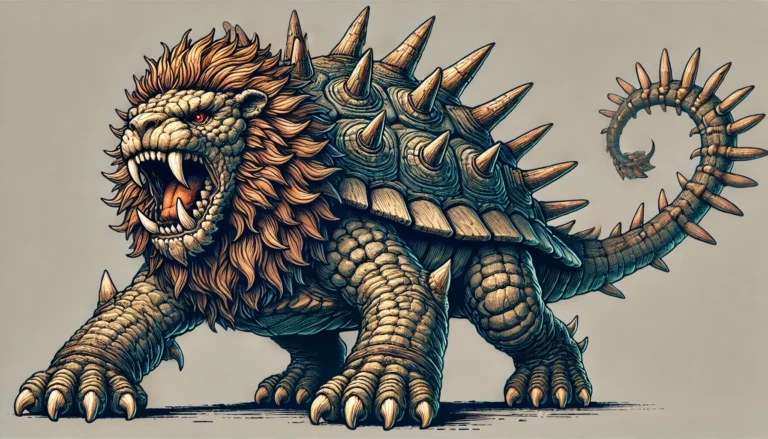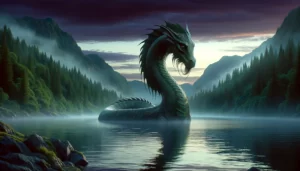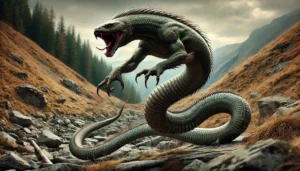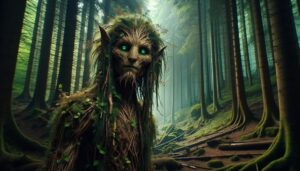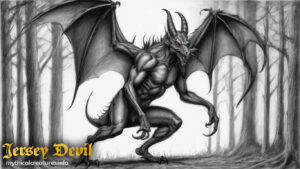Table of Contents
Origins
The Tarasque is a formidable creature rooted deeply in French folklore, specifically from the region of Provence. The legend of the Tarasque originates from the medieval tales of Saint Martha, a biblical figure who, according to the story, tamed the beast. This myth has been passed down through generations, solidifying the Tarasque’s place in the cultural and mythical history of France. The legend likely combines elements from various sources, including ancient Celtic and Roman myths, reflecting the region’s diverse cultural heritage.
Family
In the realm of mythical creatures, the Tarasque is often classified among dragon-like entities. However, it possesses unique characteristics that distinguish it from typical dragons. Some sources suggest that the Tarasque is a hybrid beast, blending features from different animals, which contributes to its fearsome reputation. Despite its dragon-like qualities, it lacks the ability to fly, which is a common trait among traditional dragons.
Appearance

Head: The head of the Tarasque is often depicted as lion-like, suggesting a fierce and predatory nature. It features sharp teeth and a powerful jaw, capable of inflicting severe damage. Some descriptions also include dragon-like elements such as reptilian eyes and scaly skin, adding to its fearsome look.
Body: The body of the Tarasque is that of a gigantic turtle, providing it with a thick, protective shell. This shell is not just a defensive feature but also contributes to its bulk and imposing presence. The shell’s surface is often illustrated with spiky protrusions or rugged textures, emphasizing its toughness and resilience against attacks.
Limbs: The Tarasque has six legs, each resembling those of a bear. These limbs are powerful and muscular, allowing it to move with surprising speed and agility despite its large size. The bear-like legs end in sharp claws, capable of tearing through flesh and materials, adding to the creature’s lethal capabilities.
Tail : its tail is serpent-like, long and flexible, with a capability to lash out and strike enemies. The tail’s movements are often depicted as swift and menacing, able to deliver powerful blows. In some illustrations, the tail might also be adorned with scales or barbs, enhancing its threat.
Overall Impression
The overall impression of the Tarasque is that of a fearsome, multi-faceted beast, combining elements of strength, defense, and aggression. Its lion-like head suggests a predatory nature, while the turtle body indicates resilience and endurance. The bear-like legs provide powerful locomotion, and the serpent-like tail adds a dynamic, striking capability.
Artistic Representations
In various artistic representations, the Tarasque is often shown in a state of motion, emphasizing its aggressive nature. It might be depicted roaring or in the midst of an attack, with its claws extended and tail poised to strike. The depictions capture the essence of a beast that is both a natural force and a mythical terror.
Symbolism in Appearance
The composite nature of the Tarasque’s appearance symbolizes the convergence of different fears and dangers. Each animal part represents a specific aspect of the creature’s terror:
- Lion’s Head: Predatory instincts and fierceness.
- Turtle’s Body: Resilience and defensive strength.
- Bear’s Legs: Power and agility.
- Serpent’s Tail: Deadliness and unpredictability.
By blending these elements, the Tarasque embodies a comprehensive threat, one that combines physical might with defensive invulnerability, making it a profound symbol of the challenges faced by those in its myth.
Abilities and Weaknesses
The Tarasque’s abilities are as varied as its appearance. Its thick, turtle-like shell provides substantial defense against conventional weapons, making it nearly invulnerable to attacks. The creature’s sheer size and strength allow it to overpower most adversaries with ease. Additionally, its serpent-like tail can deliver powerful strikes, further enhancing its combat prowess.
However, the Tarasque is not without weaknesses. According to the legend, it was Saint Martha’s faith and piety that subdued the beast, suggesting that spiritual or divine intervention can overcome its might. This aspect of the myth implies that the Tarasque, despite its physical invincibility, is vulnerable to forces beyond the natural world.
Interaction with Humans

The Tarasque’s behavior towards humans is a central theme in the legend. Initially, it is described as a menacing creature that terrorized the countryside, destroying crops, livestock, and even attacking people. Its reign of terror created an atmosphere of fear and desperation among the local population.
However, the intervention of Saint Martha marks a significant change in the Tarasque’s behavior. According to the legend, Martha approached the creature with calm and compassion, using her faith to pacify it. She led the now-tamed Tarasque back to the town, where the people, still fearful, killed the beast. This act is often interpreted as a metaphor for the triumph of faith and virtue over brute strength and terror.
Symbols and Representation
The Tarasque has become a symbol of the town of Tarascon in Provence, where the legend is said to have taken place. The town celebrates the Tarasque with an annual festival, featuring parades and reenactments of the myth. The creature is often depicted in local art and heraldry, serving as a reminder of the town’s cultural heritage.
In broader terms, the Tarasque symbolizes the overcoming of monstrous challenges through faith and courage. It represents the idea that even the most fearsome obstacles can be subdued with the right approach and mindset.
Related Myths and Stories
The legend of the Tarasque shares similarities with various other myths and stories from different cultures. The concept of a dragon or dragon-like creature being subdued by a holy or virtuous figure is a recurring theme in many mythologies. For example, the story of Saint George and the Dragon from Christian lore also involves a saintly figure overcoming a fearsome beast through faith and bravery.
Additionally, the Tarasque’s hybrid nature is reminiscent of other mythical creatures that blend features from multiple animals. The Chimera from Greek mythology, with its lion, goat, and serpent parts, is a notable example. These hybrid creatures often symbolize complex challenges or threats that require extraordinary means to overcome.
Other Creatures
Several mythical creatures share abilities or physical traits with the Tarasque. Dragons, of course, are the most obvious comparison, with their shared traits of immense strength, terrifying presence, and formidable defenses. However, unlike the Tarasque, most dragons are depicted with the ability to fly and breathe fire.
The Basilisk, another creature from European folklore, shares the ability to instill fear and cause destruction. While not physically similar, the Basilisk’s deadly nature and its own vulnerabilities to certain elements, like the Tarasque’s susceptibility to spiritual intervention, draw parallels between the two.
The Griffin, a creature with the body of a lion and the head and wings of an eagle, also shares the theme of hybrid animals in myth. While the Griffin is typically portrayed as a noble creature, its combination of features and formidable nature echo the Tarasque’s composite form.
FAQ
What are the origins of the Tarasque legend?
The legend of the Tarasque dates back to the medieval period and is rooted in both pagan and Christian traditions. It was popularized in the 12th century by the writings of Jacobus de Voragine in his "Golden Legend," which recounts the tale of Saint Martha taming the beast.
How did Saint Martha tame the Tarasque?
According to legend, Saint Martha, a figure from the New Testament, tamed the Tarasque by subduing it with prayers and the sign of the cross. She then led the now-docile creature back to the town of Tarascon, where the frightened townspeople killed it. This act is celebrated as a symbol of the triumph of faith over brute force.
What is the significance of the Tarasque in Tarascon?
The Tarasque has become a cultural symbol of Tarascon. The town celebrates its legendary connection with the creature through festivals and parades. One of the most notable events is the annual "Fête de la Tarasque," where a large effigy of the monster is paraded through the streets.
How is the Tarasque depicted in art and literature?
The Tarasque is often portrayed in various forms of art, including sculptures, paintings, and tapestries. In literature, it is typically described as a fearsome, multi-limbed monster with a blend of features from different animals, emphasizing its monstrous nature.
Are there any other creatures similar to the Tarasque in folklore?
Yes, many cultures have legends of dragon-like creatures that share similarities with the Tarasque. Examples include the English dragon, the German Lindworm, and various Asian dragon myths. These creatures often symbolize chaos, danger, and the unknown, much like the Tarasque.
What lessons or morals are associated with the Tarasque legend?
The legend of the Tarasque is often interpreted as a story of good overcoming evil, faith conquering fear, and the power of piety and compassion. Saint Martha's taming of the Tarasque is seen as an example of how kindness and faith can subdue even the most fearsome of challenges.
